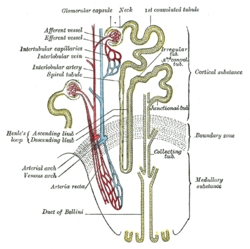Juxtamedullary nephron
This article needs additional citations for verification. (September 2014) |
| Juxtamedullary nephron | |
|---|---|
 Nephron of the kidney without juxtaglomerular apparatus | |
| Details | |
| Precursor | Metanephric blastema |
| Anatomical terminology | |
A juxtamedullary nephron is a type of nephron, found only in birds and mammals. Medullary refers to the renal medulla, while the juxta (Latin: near) refers to the relative position of the renal corpuscle, which in these nephrons are near the medulla (but still in cortex. junction) . In other words, a juxtamedullary nephron is one where the renal corpuscle is close to the medulla, and the proximal convoluted tubule and its associated loop of Henle occur at a deep position compared to most other nephrons.
This type of nephron is relatively rare, and only comprise 20–30% of the nephrons in the human kidney. However, in most depictions of the nephron, it is a juxtamedullary nephron which is depicted. The greater gradient in the deep medulla make this type of nephron do more "work" than more shallow nephrons, and their vertical nature makes them easier to illustrate. It is these nephrons which are responsible for the development of the osmotic gradients in the renal medulla, which are used to concentrate urine. These nephrons have a longer loop of henle than cortical type of nephrons. Also the hairpin bend penetrates up to the inner zone of medulla[1]
References
- ^ "Regulation of Urine Concentration". Anatomy & Physiology. CliffsNotes. Archived from the original on 25 October 2012. Retrieved 27 November 2012.
{{cite web}}: Unknown parameter|deadurl=ignored (|url-status=suggested) (help)
